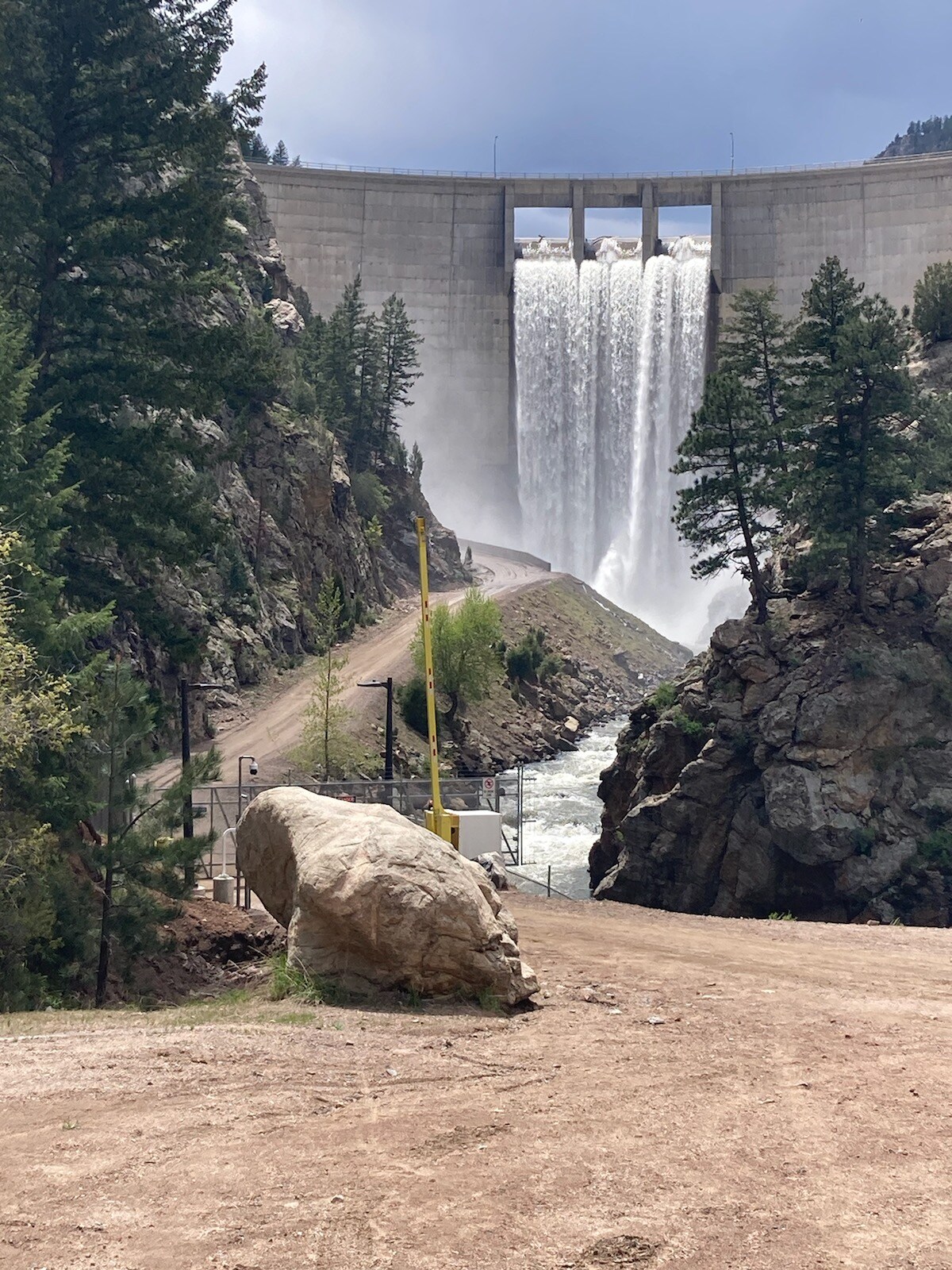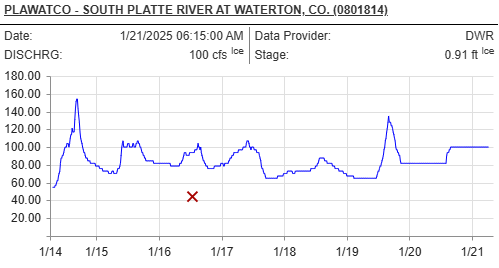Waterton Canyon on the South Platte River isn’t just another spot on the map—it’s a rite of passage for fly fishing enthusiasts. If you’re looking to sharpen your skills, this is the place. The canyon’s reputation as one of the most technical fisheries around isn’t just for show; it’s earned. The fish here are seasoned opponents, often called “spooky,” requiring precision in every cast. With its clear waters and complex currents shaped by large granite boulders, the river demands your full attention and best technique.
South Platte River Fishing Report – Waterton Canyon – January 2024
Waterton Canyon offers a serene and accessible winter fishing destination just outside Denver. With flows steady at 40-60 CFS, the water is low and clear, requiring technical precision and stealth to fool the canyon’s wily trout. Trout are concentrated in deeper runs and slower pools, feeding on midges and the occasional Blue Wing Olive during warm afternoons. The dramatic canyon scenery, paired with minimal crowds, makes this stretch a winter gem for patient anglers.
Late morning to early afternoon is the sweet spot, as the sun warms the water and trout activity increases. Nymphing remains the most consistent tactic, though dry fly opportunities arise during sporadic midge hatches. For those targeting larger trout, streamers fished slowly along structure may provoke a strike. Dress warmly and prepare for a peaceful, scenic day on the water. We might skip this spot for a while. A long while. At least until the pressure of other anglers subsides or the bit and waters heat up.
Conditions Summary
%20(4).png?width=800&height=175&name=Guide%20Rating%20(800%20x%20175%20px)%20(4).png)
- Flow Rate: 40-60 CFS
- Water Temperature: 34-38°F
- Clarity: Crystal clear
- Best Times: Late morning to early afternoon
- Current Conditions Rating: ⭐⭐ (2/5) – Stunning scenery and peaceful fishing, but low flows and cold water make for a technical challenge.
River Flow Chart
Waterton Canyon Hatch Chart (South Platte River)
| Month | Primary Hatches | Effective Patterns |
|---|---|---|
| December | Midges | Zebra Midge (#20-24), Black Beauty (#20-24) |
| January | Midges | WD-40 (#20-24), Miracle Midge (#20-24) |
| February | Midges | Griffith’s Gnat (#20-24), Black Beauty (#20-24) |
Top 3 Flies for the Week
- Dry Fly: Griffith’s Gnat (#20-24) – Perfect for calm, sunny afternoons when midges hatch.
- Nymph: Zebra Midge (#20-24) – Effective in deeper runs and slower water.
- Streamer: Olive Woolly Bugger (#8-10) – Best for targeting larger trout near structure during low-light conditions.
Tips Fly Fishing on the Waterton Canyon Section
Seasonal Tip
Low flows and cold water demand patience and stealth. Approach pools carefully, use long leaders, and focus on deeper holding water.
Dry Fly
Sporadic midge hatches offer surface action on sunny days. Target risers in calm eddies and tailouts with small, delicate patterns.
Nymphing
A double-nymph rig featuring a Zebra Midge and Black Beauty is your go-to setup. Add enough weight to get your flies down to feeding fish in deeper runs.
Streamer Fishing
Streamers like Olive Woolly Buggers or small sculpin patterns can coax larger trout from structure. Use slow, deliberate retrieves.
Access Points
Waterton Canyon Trailhead
- Description: The main entry point to Waterton Canyon, offering miles of fishable water along a scenic trail.
- Why Fish Here: Easy access to diverse water types, from riffles to deep pools.
- Location: Waterton Road, just south of Chatfield Reservoir.
- Locals' Rating: ⭐⭐⭐⭐
Mid-Canyon Riffles
- Description: A stretch featuring shallow runs and riffles with good holding water.
- Why Fish Here: Great for nymphing and spotting rising trout during hatches.
- Location: Approximately 2 miles from the trailhead along the Waterton Canyon trail.
- Locals' Rating: ⭐⭐⭐½
Upper Canyon Pools
- Description: A quieter section with deeper pools and excellent winter holding water.
- Why Fish Here: Ideal for nymphing and targeting larger trout in slower water.
- Location: 4-5 miles from the trailhead, near the Strontia Springs Dam.
- Locals' Rating: ⭐⭐⭐⭐
Local Regulations and Notes on Landowner Rights
Waterton Canyon is a catch-and-release fishery with barbless hooks encouraged to protect its trout population. Public access is managed by Denver Water, and the trail remains open year-round, though occasional maintenance closures may occur. Check regulations before heading out, and respect other trail users, as this area is popular with hikers and cyclists.
.png?width=300&height=100&name=Copy%20of%20Rise%20Beyond%20Logo%2012.31.24%20(300%20x%20100%20px).png)
.png)
.png?width=2240&height=1260&name=Colorado%20Stream%20Fly%20Fishing%20Reports%20(3).png)

-2.png?width=500&height=500&name=New%20Amazon%20Listing%20Images%20-%20Streams%2c%20Hoppers%20and%20Dries%20(9)-2.png)

